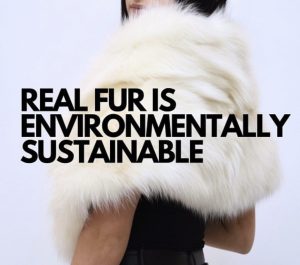By Christos Taltsidis
The foundation of a sustainable furrier starts with ethical fur. There are several ways to source fur ethically, including second-hand furs, government-regulated fur sourcing, and by being conscious overall. It helps to create a trustworthy brand that people respect. As the former furrier for Nordstrom’s midwest locations and founder of my own fur and leather business, Christos Fur & Leather, furriers should prioritize ethics and disclose as much information about their products as possible. Fur origin, approximate age, sourcing, and traceability should be readily available for all current and potential clients.
Trade Materials ~ Vintage Furs
Second-hand or pre-owned outerwear has a story. When I work with vintage fur, I think of the woman who originally wore this coat and all the places the coat went. The beauty of fur and other earth-made materials is their longevity. With proper care, furs can exist through countless eras and trends and have the ability to become modernized to fit into today’s style. Honoring fashion history and keeping styles alive with the rebirth of redesigned fur without the need for new fur.
Currently, younger generations want and deserve to understand where their clothes, food, etc. are coming from; with many of them not wanting animals hurt or disrespected in the process. Respecting the course of the new generations and listening to them is optimal for any sustainable brand.

Respect Nature
When an animal is mistreated and lives in unsuitable conditions, they, like humans, produce stress hormones like cortisol. Stress affects all aspects of the animal’s body, including their fur. When they are raised in improper conditions, their overall fur quality suffers because, just like people, how we take care of ourselves will show. By asserting care, respecting, and following government regulations, it not only allows animals to live a respectable life but also promotes sustainability because the fur lasts and it is the best quality fur.
Some animals are perilous to their environment, making them an invasive species. Sourcing fur from invasive species actually solves this issue and ensures no land is eaten and no other species are endangered. Saving an entire ecosystem.
The bottom line is that we are a part of nature just as much as animals. To serve and cater to the people, we must consider and respect the animals in the process. This is nature’s natural balance.
Honesty is the Best Policy
Be transparent with your customers. Always offer as much information as possible. Modern- day consumers appreciate a full understanding of a product’s full life cycle. Clients with this understanding become part of your story as a brand.
All in all, creating a sustainable fashion brand, especially as a furrier, can be difficult. Promoting natural materials, both secondhand and new, means promoting longevity and controversy. My team and I understand that buying high-quality goods, especially fashion, comes with a hefty price tag, but we advise people to view it as an investment. Fur, leather, cotton, linen, wool, cashmere, and silk all last a lifetime but biodegrade within 6 months. It is our job as furriers and fashion retailers to ensure these fibers are brought to the public ethically. We must honor nature and do our best to stay in balance with it.
For more information on ethical fur.

